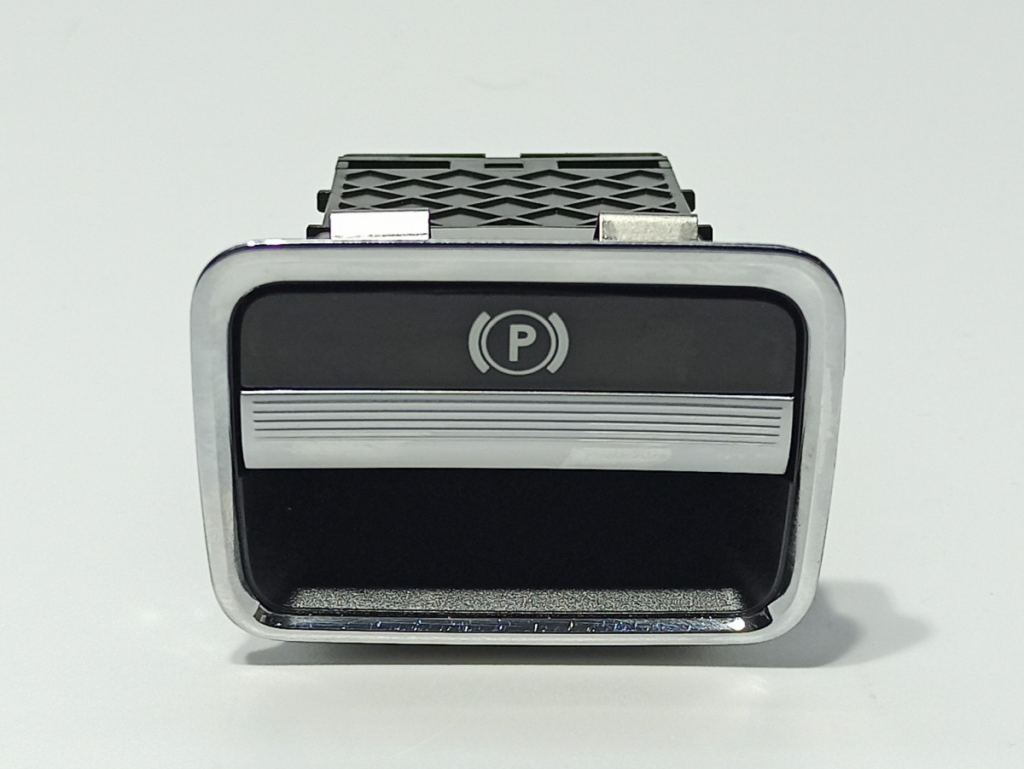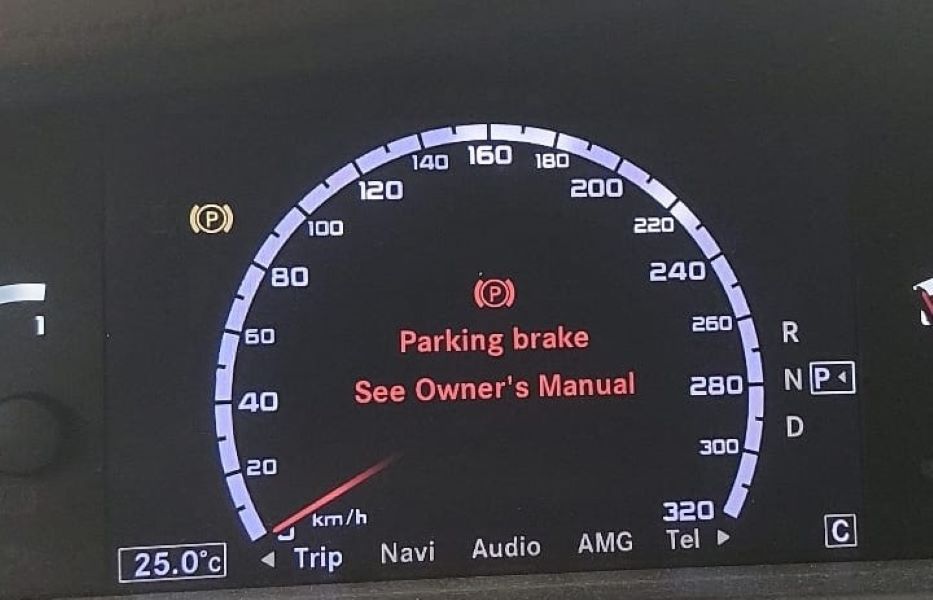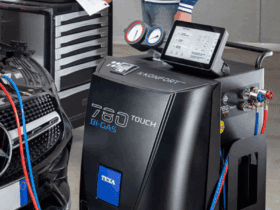Table of Contents
Parking Brake – See Owner’s Manual” Warning: Mercedes Diagnosis & Fixes
When your Mercedes displays “Parking Brake – See Owner’s Manual”, it’s indicating a fault in the electronic parking brake (EPB). This may prevent the brake from engaging or disengaging, so resolving it promptly is crucial for both safety and vehicle functionality
Common Causes & Diagnostics
| Cause | Symptoms | Diagnostic & Fix |
|---|---|---|
| Sticking rear caliper actuator | Warning appears after wash/rain; brake won’t release | Remove wheel, lubricate/lubricate actuator; replace if seized |
| Faulty actuator motor/module | No engagement/disengagement on button use | Use scanner to test, replace module or actuator assembly |
| Pedal-switch (mechanical EPB) | Yellow/red light; parking pedal not released signal | Check and reposition switch; replace faulty pedal switch mechanism |
| Bad parking brake switch | Light stays on even if brake appears released | Inspect and replace switch under dash |
| Weak battery / low voltage | Random warning after startup or during use | Test battery/voltage; recharge or replace weak battery |
| ABS/EPB module or wiring fault | Flashing “Park” light, refusal to release brake | Scan EPB module codes; repair wiring or replace EPB unit |
Step‑by‑Step Fix Flow
- – Test battery voltage: Should be ≥12.4 V idle and ~14 V running.
- – Restart & hold EPB switch for ~10 seconds as a reset method.
- – Listen for actuator noise when pressing EPB button defective unit may stay silent.
- – Lift the rear wheel, apply penetrating oil to actuator gears/pistons.
- – Check mechanical switch (on pedal variants): access under dash, ensure it’s triggered properly.
- – Scan EPB module for codes such as “terminal 15” or actuator faults; log and address errors.
- – Replace components: actuator, module, or EPB assembly; include battery, wiring, and fuse checks.
A Diagnostic Case Study: Parking Brake See Owners Manual
Parking Brake See Owners Manual is a warning message that appeared on the dashboard of a Mercedes-Benz S-Class W221, prompting concern for the owner. Despite the vehicle’s reputation for advanced technology and luxurious performance, even high-end models like the W221 can encounter electronic faults.
Parking Brake See Owners Manual appeared in a W221 equipped with Mercedes’ electronic parking brake system an innovation designed to automatically engage when the vehicle is parked and disengage when driving. While this system typically enhances safety and convenience, a malfunction can disable proper brake function, posing a risk during parking or incline scenarios.
The warning message indicated the system had detected an error, but offered no specific details, leading the technician to carry out a full diagnostic scan. This case study highlights a situation where the electronic parking brake system malfunctioned, requiring detailed diagnostic work to identify and resolve the issue.
Mercedes parking brake see owners manual Background
The S-Class model in question is a W221, featuring the advanced electronic parking brake system typical of Mercedes-Benz’s modern offerings. This system is designed to provide convenience and safety, automatically engaging when the vehicle is parked and disengaging upon driving.

Customer Complaint
The owner reported a persistent issue: a warning message stating “Parking Brake See Owners Manual” appeared, indicating a malfunction. Despite attempts to activate the parking brake, there was no response, raising concerns about the vehicle’s safety when parked on inclines or slippery surfaces.

Diagnostic Approach
1. Initial Testing and Short Tests: The diagnostic journey began with a series of short tests aimed at replicating the problem and understanding its nature. The warning message was confirmed, but the cause remained elusive.

2. Checking the Parking Brake Control Unit: The next step involved inspecting the parking brake control unit for any fault codes or irregularities. Despite thorough testing, no apparent faults were detected, leaving the issue unresolved.

3. Examination of Mechanical Components: Mechanical components related to the parking brake were meticulously examined. All components were found to be in proper working order, with no signs of damage or wear that could contribute to the malfunction.

4. Voltage Testing and Wiring Inspection: Voltage tests confirmed the integrity of the parking brake switch and associated wiring. The absence of damage or irregularities suggested that the issue lay elsewhere.
5. Diagnostic Tools: Utilizing the Xentry diagnostic system, technicians sought further insights into the problem. However, the diagnostic tool indicated no related faults, deepening the mystery.
Findings
The investigation pointed towards the parking brake control unit as the likely source of the issue, despite no explicit faults being recorded. This conclusion was drawn after ruling out all other potential causes.

Solution
With the parking brake control unit identified as the potential culprit, a decision was made to replace it. The replacement process was executed with precision, ensuring all components were correctly installed and calibrated.
Post-replacement testing confirmed the effectiveness of the solution. The parking brake functioned flawlessly, and the warning message ceased to appear, restoring the vehicle’s full operability.

This case study underscores the importance of a systematic approach to automotive diagnostics. The resolution of the parking brake issue in the Mercedes-Benz S-Class required careful analysis, a process of elimination, and reliance on expertise and diagnostic tools.
DIY vs Professional Actions
| Task | DIY-Friendly | Professional Recommended |
|---|---|---|
| Battery voltage test | Yes | — |
| Reset EPB with switch hold | Yes | — |
| Actuator lubrication (rear wheels) | Yes | — |
| Pedal-switch access & reposition | Moderate | If unsure |
| EPB module fault scan | Needs scanner | MR-approved shop |
| Actuator or EPB assembly replacement | No | Specialist needed |
| Wiring & fuse troubleshooting | Moderate | Specialist advised |
How to release parking brake?
Releasing the parking brake in a Mercedes S-Class W221 can be a straightforward process, but it depends on the type of parking brake system installed in the vehicle.
The W221, produced between 2005 and 2013, can have either a mechanical foot-operated parking brake or an electronic parking brake (EPB), depending on the model year and configuration. In the video below are the detailed steps for both systems:
What is Parking brake ?
A parking brake, also known as an emergency brake or handbrake, is an essential component of a vehicle’s braking system designed to keep the vehicle stationary when parked, especially on inclines.
It serves as a backup to the primary hydraulic brakes, offering an additional layer of safety. Here’s a detailed explanation of how parking brakes work, their components, types, and functions:

Components of a Parking Brake System
Electronic motors or solenoids that engage the parking brake with a button or switch.
1. Parking Brake Lever or Pedal:
- – Hand Lever: Typically located between the front seats or on the dashboard.
- – Foot Pedal: Positioned on the driver’s side, near the footwell.
2. Cables and Linkages:
- – Connects the lever or pedal to the brakes. These are often made of steel to ensure durability and resistance to tension.
3. Brake Mechanism:
- – Drum Brakes: In older vehicles, the parking brake often engages the rear drum brakes.
- – Disc Brakes: In modern vehicles, the parking brake engages a separate set of brake pads on the rear disc brakes.
4. Actuators (for Electronic Parking Brakes):
- – Electronic motors or solenoids that engage the parking brake with a button or switch.
How Does a Parking Brake Work?
The working mechanism of a parking brake can vary slightly depending on whether it’s a traditional mechanical system or an electronic one. Below is a detailed explanation of both types:
Electronic Parking Brake (EPB)
Electronic Parking Brakes represent a modern advancement in parking brake technology, automating the engagement and release process.

1. Engagement:
- – Button Activation: Pressing a button or flipping a switch on the dashboard sends an electronic signal to the parking brake control unit.
- – Actuator Mechanism: The control unit activates electric motors or solenoids, which engage the brake mechanism.
- – Friction Application: These motors apply pressure to the brake calipers, pressing the pads against the rotors, securing the vehicle in place.
2. Disengagement:
- – Release Button: Pressing the release button sends another signal to disengage the brake.
- – Automatic Release: Many EPB systems automatically release when the accelerator is pressed, provided the seatbelt is fastened and the car is in gear.
3. Advantages:
- – User-friendly with automatic functions.
- – Compact design, freeing up space in the vehicle cabin.
- – Integrated with vehicle stability systems for enhanced safety.
4. Disadvantages:
- – Higher cost of repairs and maintenance.
- – Reliance on electronic systems may lead to failures due to electrical issues.
Detailed Working Process
Electronic Parking Brake (EPB) Operation
1. Electronic Control:
- – A central control unit monitors and controls the brake system.
- – Sensors detect the vehicle’s position, ensuring appropriate engagement.
2. Motorized Engagement:
- – Electric motors within the brake calipers receive signals to engage.
- – A gear mechanism applies the necessary force to clamp the pads onto the rotor.
3. Automatic Functions:
- – Integration with ABS and traction control for stability.
- – Automatic engagement when the vehicle is turned off or placed in “Park.”
4. Diagnostics and Safety:
- – Self-diagnostic capabilities alert drivers to faults.
- – Emergency release functions are available in case of electronic failure.
The parking brake is a vital component of vehicle safety, designed to secure the vehicle when stationary and act as a backup to the main braking system. Understanding how parking brakes work, their components, types, and common issues can help ensure proper maintenance and operation.
Whether mechanical or electronic, regular checks and maintenance can prevent potential failures and ensure that the vehicle remains safe and reliable.
Frequently Asked Questions
What does this warning mean?
It indicates a fault in the electronic parking brake often a stuck actuator, failed motor, switch issue, low voltage, or EPB module fault.
Why did it appear after washing the car?
Moisture can cause rear‑wheel actuators to seize lubricating them often resolves the issue.
Can I reset it myself?
Yes, restart your engine and press/hold the EPB button for 10 s. If it doesn’t reset, proceed with diagnostics.
Why won’t the parking brake release?
The actuator may be faulty, module wired incorrectly, or yellow pedal switch not signaling the system.






Leave a Reply